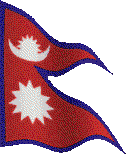
 The palace of Kantipur or Kathmandu in old days used to be in Hanuman Dhoka Durbar Square. There are hundreds and thousands of small temples and statues of different Hindu gods inside and outside the palace. The name Hanuman Dhoka came from the word Hanuman and Dhoka where Hanuman is a popular and dedicated disciple of the Hindu god Ram and the dhoka means door in Nepali language. There is a statue of Hanuman near the gate of the palace so the place has been named as Hanuman Dhoka. There are so many god and goddess around the palace that it would take years to study all of them, well if you are permitted to enter the premises that is.
The palace of Kantipur or Kathmandu in old days used to be in Hanuman Dhoka Durbar Square. There are hundreds and thousands of small temples and statues of different Hindu gods inside and outside the palace. The name Hanuman Dhoka came from the word Hanuman and Dhoka where Hanuman is a popular and dedicated disciple of the Hindu god Ram and the dhoka means door in Nepali language. There is a statue of Hanuman near the gate of the palace so the place has been named as Hanuman Dhoka. There are so many god and goddess around the palace that it would take years to study all of them, well if you are permitted to enter the premises that is.Since my childhood I have been up and down the road of the square and I have always noticed lots of tourists wandering around the premises of the durbar square. The main festival where lots of demonstration of the jatra (festival) occurs in one of the important jatra called Indra Jatra. Most of the temples which are closed throughout the year will open in this day. This Jatra mostly occurs in the month of September but is celebrated according to the Newari Tithi (Newari Calendar). Nowadays lots of Nepalese teenagers, mainly couples, can be seen scattered all over the places in the durbar square. Nepalese people have very conservative thoughts and kissing in public is not quite allowed. They think it as a private thing between a committed husband and wife and advise the younger ones not to practice that in the public. But the changes in the teenagers and mostly as they are westernizing the kissing is not a new thing these days. You can find lots of teenage couples making out in some places below the temples or on the street wherever there is some place to sit. It is quite obvious that even old people are used to it as they are often seeing those sorts of scenario quite often. Yet the majority of the people take it in a negative way as they think temples are the holy place so no one should practice such acts of privacy in public especially in holy places.
Those are the things I usually see when I pass by the Hanuman Dhoka Durbar Square. I am sure in years to come the generations will be changed with the world changing day by day and I wonder what our future would leads us to…






